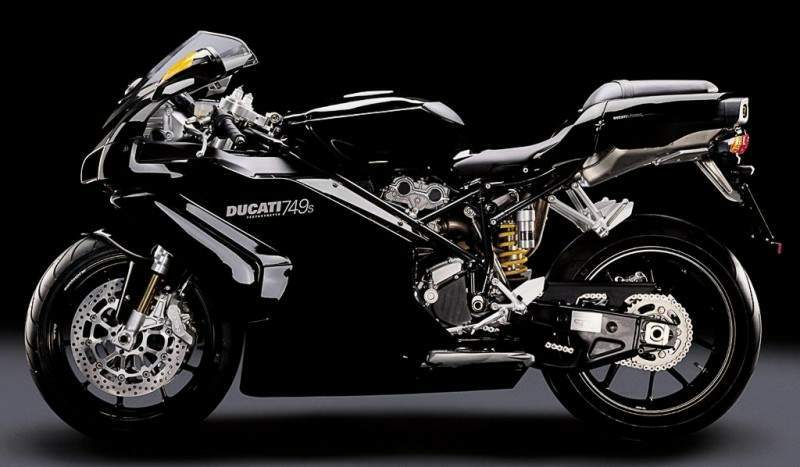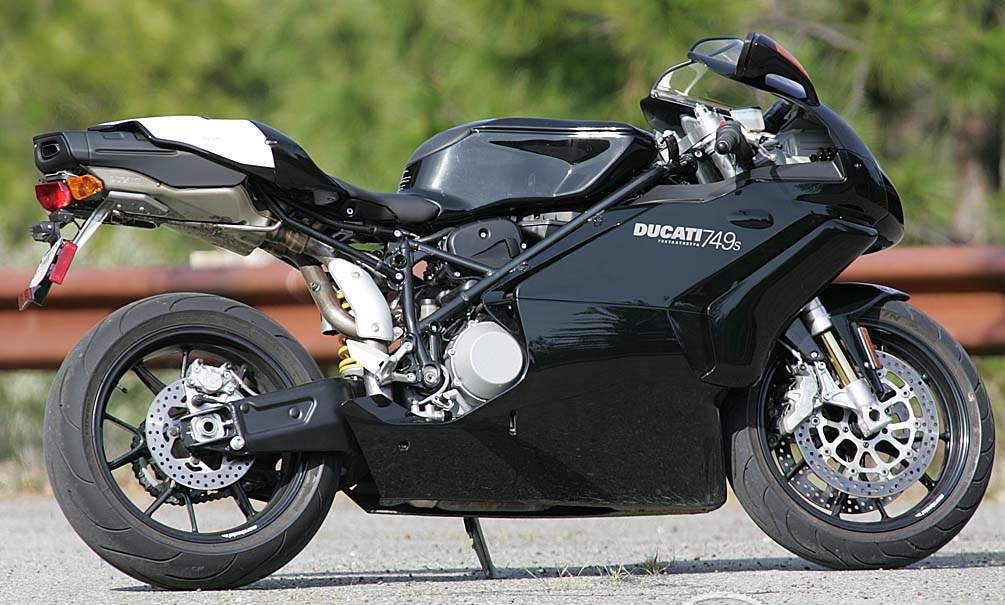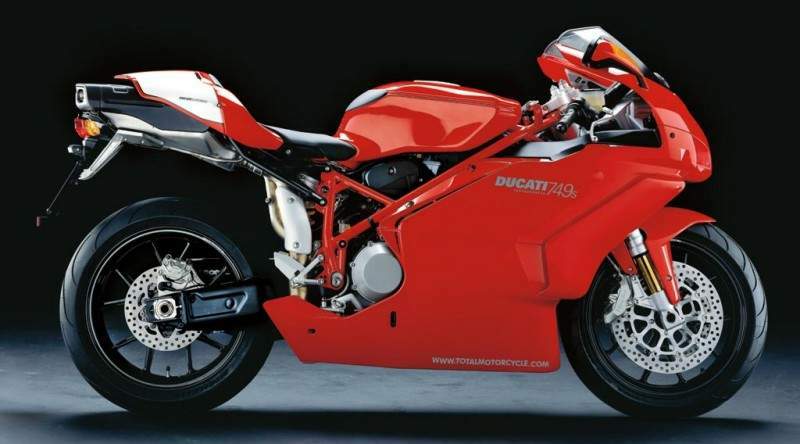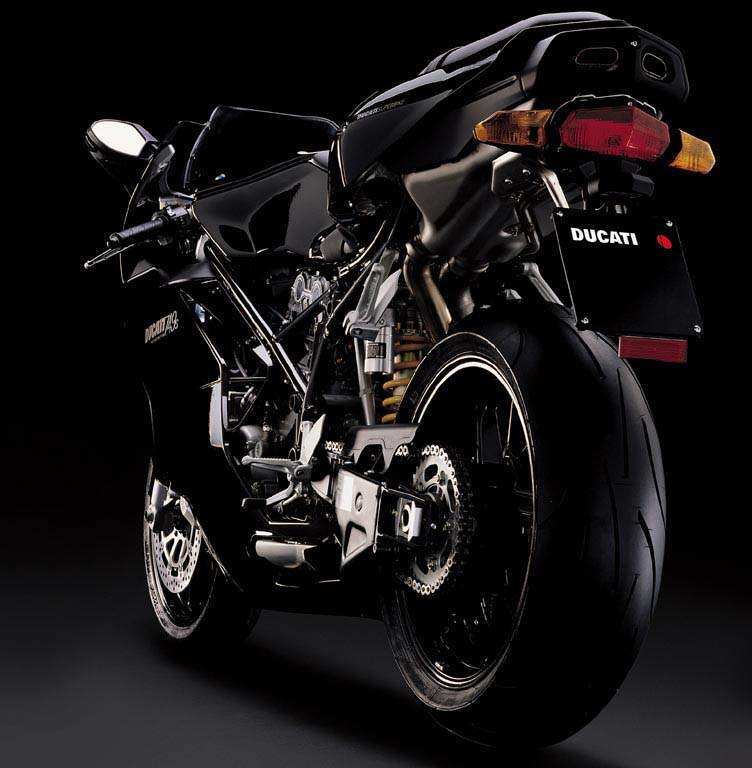
|
|
|
|
|
|
Classic Bikes
Custom Bikes
Individual
Racing Bikes AJP
AJS
Aprilia
Ariel
Avinton / Wakan
Bajaj
Benelli
Beta
Bimota
BMW
Brough Superior
BRP Cam-Am
BSA
Buell / EBR
Bultaco
Cagiva
Campagna
CCM
CF Moto
Combat Motors
Derbi
Deus
Ducati
Excelsior
GASGAS
Ghezzi Brian
Gilera
GIMA
Harley Davidson
Hero
Highland
Honda
Horex
Husaberg
Husqvarna
Hyosung
Indian
Jawa
Kawasaki
KTM
KYMCO
Laverda
Lazareth
Magni
Maico
Mash
Matchless
Mondial
Moto Guzzi
Moto Morini
MV Agusta
MZ / MuZ
NCR
Norton
NSU
Paton
Peugeot
Piaggio
Revival Cycles
Roland Sands
Royal Enfield
Sachs
Sherco
Sunbeam
Suzuki
SWM
SYM
Triumph
TVS
Ural
Velocette
Vespa
Victory
Vincent
VOR
Voxan
Vyrus
Walt Siegl
Walz
Wrenchmonkees
Wunderlich
XTR / Radical
Yamaha
Zero
Video
Technical
Complete Manufacturer List
|
Ducati 749S
|
| . |
|
Make Model |
Ducati 749S |
|
Year |
2005 |
|
Engine |
Four stroke, 90°“L”twin cylinder, DOHC, desmodromic 4 valve per cylinder, belt driven |
|
Capacity |
748.4 cc / 45.7 cu in |
| Bore x Stroke | 90 x 58.8 mm |
| Cooling System | Liquid cooled |
| Compression Ratio | 12.3:1 |
| Lubrication | Wet sump |
| Engine Oil | Synthetic, 10W/40 |
| Exhaust | Single steel muffler with catalytic converter |
|
Induction |
Marelli electronic fuel injection, 54 mm throttle body |
|
Ignition |
Digital CDI |
|
Spark Plug |
Champion, RA6HC, NGK CR9VX |
| Starting | Electric |
|
Max Power |
85 kW / 116 hp @ 10500 rpm |
|
Max Torque |
82.4 Nm / 8.4 kgf-m / 60.8 ft-lb @ 8500 rpm |
| Clutch | Dry multiplate with hydraulic control |
|
Transmission |
6 Speed |
| Primary Drive Ratio | 1.84:1 (32/59) |
| Gear Ratios | 1st 2.466 / 2nd 1.765 / 3rd 1.400 / 4th 1.182 / 5th 1.043 / 6th 0.958:1 |
| Final Drive Ratio | 2.78:1 (14/39) |
| Final Drive | Chain |
| Frame | Tubular ALS450 steel trellis |
|
Front Suspension |
Showa 43mm fully-adjustable upside-down fork with TiN |
| Front Wheel Travel | 125 mm / 4.9 in |
|
Rear Suspension |
Progressive linkage with fully-adjustable Showa monoshock |
| Rear Wheel Travel | 128 mm / 5.0 in |
|
Front Brakes |
2 x 320mm Disc, 4 piston calipers |
|
Rear Brakes |
Single 245 mm disc, 2 piston caliper |
| Front Wheel | New Y-shaped 5 spoke design light alloy, 3.50 x 17 |
| Rear Wheel | New Y-shaped 5 spoke design light alloy, 5.50 x 17 |
|
Front Tyre |
120/70 ZR17 |
|
Rear Tyre |
180/55 ZR17 |
| Rake | 23.5° - 24.5° |
| Trail | 97 mm / 3.8 in |
| Dimensions |
Length: 2095 mm / 82.5 in Width: 730 mm / 28.7 in Height: 1090 mm / 42.9 in |
| Wheelbase | 1420 mm / 55.9 in |
| Seat Height | 780 mm / 30.7 in |
|
Dry Weight |
199 kg / 438 lbs |
|
Fuel Capacity |
15.5 L / 4.1 US gal / 3.4 Imp gal |
| Reserve | 3.0 L / 0.8 US gal / 0.7 Imp gal |
|
Consumption Average |
5.6 L/100 km / 18 km/l / 42.3 US mpg / 50.8 Imp mpg |
|
Braking 60 km/h - 0 |
12.0 m / 39.4 ft |
|
Braking 100 km/h - 0 |
37.5 m / 123.0 ft |
|
Standing ¼ Mile |
11.2 sec / 203 km/h / 126 mph |
|
Top Speed |
250 km/h / 155 mph |
| Instrumentation | Speedometer, rev counter, high beam indicator, turn signals, oil pressure warning light, low fuel warning light, neutral light, water temperature, Immobilizer |
An exclusive version equipped with
top quality components. A transitional phase between the R version and the basic
version, designed to meet with the approval of demanding and informed customers.
More powerful than the 749, with more sophisticated chassis and running gear,
that make it possible to achieve very fast lap times, all combine to make this
machine a highly interesting classic proposal in the purest Ducati style.
Style
All bodywork parts have exactly the same shape on all the Ducati Superbikes, so
the only distinctive elements on the 749S are details that make a difference to
the ergonomics of the machine, which although they may go unnoticed at first
glance, offer easily perceptible advantages in race conditions. This is the case
of the footpegs, which offer several alternative positions to enable the rider
to find the ideal posture, and the tank-seat combination, which on the single-seater
version, can be moved fore and aft to find the preferred weight distribution.
The styling of the bike is also influenced by the professional type suspension
making the overall appearance of the 749S meaner and more aggressive.
Chassis
Homologated for road use although designed primarily for use on the track, the
749S features a top quality chassis and running gear, with advanced suspension
systems and the ability to find the ideal set-up that are even more
sophisticated than those provided for the basic 749. The top of the range Showa
production was chosen for the suspension, with a 43 mm upside-down fork and TiN
coated stanchions, and with a professional rear monoshock. The steering damper
on the 749S is equipped with an eccentric terminal, a solution imposed by the
presence of an adjustable rake steering head. Ducati allows riders to choose
between a rake of 23.5 and 24.5 degrees depending on personal taste and road or
track conditions. But that's not all: the 749S can be personalised for each
rider, thanks to the five footrest position options.
Powerplant
The 749S twin cylinder engine was developed by exploiting the experience gained
with official race machines. Important details, such as the connection system
between the valve stem and the closing rocker shim, come directly from the Borgo
Panigale race department and have made it possible to achieve extreme valve
timing. The result is 116 HP at 10,500 rpm, but this excellent value was
obtained without detracting from flexibility of the power band (torque is 8.4
kgm at 8,500 rpm), which is one of the main qualities of this model, and while
maintaining the utmost reliability.

Review
Ducati 749S Italian Class
Just looking at the 749 is enough to convince you this is a
unique and special bike in this collection. Compared to the
stubby multi-cylinder bikes in this test, the Duc looks long and
lanky. Indeed, its 55.9-inch wheelbase is more than an inch
longer than the rest of the bikes and a massive 1.6 inches
rangier than the compact R6. The little Superbike feels
different, too, with an ultra-slim midsection, long reach to the
bars and a low, hard seat. A rider is stretched out more than on
the others, but the bike feels so cool underneath that some
riders quickly forgot about any pain it might induce.
"The 749 doesn't compromise form for function," says our
Editorial Director Ken Hutchison. "The bike is a purpose-built
carving machine, so if you are looking for a nice comfortable
ride this might not be for you. Funny thing is, this bike has a
wide array of adjustability with fore/aft seat adjustments as
well as variable pegs mounts. But its bars are quite low, and
that's what causes that ache after a long ride."
When we last tested a 749 in 2004, the Dark edition came up a
bit short on the dyno with its 94.8-hp pull. Its bounty of
torque couldn't overcome is top-end deficiency. The 749S we
included in this shootout had no such problem, as its 106.6-hp
peak exceeded the Triumph's and nearly matched the revvy
Yamaha's. And, naturally, nothing else in this group could match
its 55.1 lb-ft torque peak.

"The sweet V-Twin offers up the type of low-end and midrange
grunt that makes you not worry so much about how comfortable you
may or may not be," adds Kenny, "and it reminds you why Ducatis
are so much fun to ride on your favorite canyon road."
Getting to your favorite canyon road, however, is less
pleasurable. Imagine driving an early-'70s Ferrari and you'd be
close: heavy clutch, wide turning radius, relatively balky
shifting and crap rearward visibility.
But get your Italian steed pointed for the hills and the
perception changes from awkward to bella. Thoughts of a
long reach to the wheel, er, 'bars become vapor and instead turn
to visions of Troy Bayliss nearly dragging his elbow over the
curbing in one of Monza's chicanes. A booming, sonorous
soundtrack bounces off canyon walls, and you just know the
trophy girl at the end of the road is going home with you.

The 748cc Twin pumps out power everywhere, responsive and
obedient, and its tubular trellis chassis is virtually
unflappable. On the right kind of road - full of sweepers and
long sightlines - the Ducati offers an experience the more
frenetic competition just can't match.
It's in the tighter stuff where the 749 feels less adroit. Part
of the blame lies in its second-laziest 24.5-degree rake angle,
but it's a combination of its long wheelbase and extra poundage
that holds it back. At 435 lbs with its tank empty, the Duc
weighs a significant 28 lbs more than the next heaviest of the
group, the GSX-R, and a massive 45 lbs lardier than the
flyweight Daytona.
Thankfully, serious braking power is supplied via 4-piston,
4-pad Brembo calipers biting on dinner-plate-sized 320mm rotors.
Although the calipers aren't the trendy radial-mount type, the
blend of braided-steel brake lines and the largest discs in the
group allow eyeball-ejecting deceleration. Our only gripes are
an initial bite that can be a bit harsh and a marginal lack of
feel. And, depending on the tires, the bike might stand up when
trail-braking.
Thus far we've been able to paint a fairly flattering picture of
the debonair Italian, but when ranked as a streetbike,
there are a few rough seams in the Armani.
Along with punishing ergonomics, a rider has to endure
considerable heat coming off the engine and exhaust. Gear
changes are accomplished with a bit more effort and less
precision, and the only slipper clutch it has is controlled by
your left hand. You also won't find a handy gear-position
indicator or even a redline on the tach. Tie-down hooks and
on-board storage are a figment of your imagination, and trips to
your dealer for valve-clearance inspections will come just 6000
miles apart, mercifully longer than the frequent gas stops
forced by the minuscolo 4.1-gallon fuel tank. Also, your
favorite passenger will be taking the car.
But, let's face it, if you've got the deep pockets to afford a
$15,000 single-seater, you probably have something else in the
garage that's a bit more practical. For those who are in that
fortunate situation, you'll be happy knowing your Italian
speedster offers up a riding experience that in many ways
surpasses that of any rippin' upstart that revs north of 12,000
rpm.
Highs:
A chassis as good as anything
Sex appeal of an exotic
Only game in town for V-Twin enthusiasts
Sighs:
Platinum price tag
S&M ergos
Is a redline too much to ask for?
Source Motorcycle-USA

|
Any corrections or more information on these motorcycles will be kindly appreciated. |